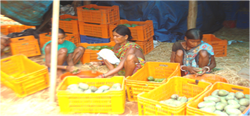 A significant proportion of tribals have been engaged in shifting cultivation, especially on high lands without soil conservation measures with a high level of soil erosion, in Kashipur block of Rayagada district of Odisha. The place is located in the interior of forest at 500 km away from the state capital, Bhubaneswar. This practice was leading to the loss of land productivity, soil fertility and decrease in carrying capacity of the available natural resources. These lands are best suited for tree based perennial horticultural crops, such as mango having commercial potential in the area. Though the State Government has been making efforts since long, but somehow the tribals could not realize the commercial value of the mango. Lack of result demonstration, pest incidence in some of the existing orchards and absence of assured mango marketing channel were the key constraints in the way of mango cultivation.
A significant proportion of tribals have been engaged in shifting cultivation, especially on high lands without soil conservation measures with a high level of soil erosion, in Kashipur block of Rayagada district of Odisha. The place is located in the interior of forest at 500 km away from the state capital, Bhubaneswar. This practice was leading to the loss of land productivity, soil fertility and decrease in carrying capacity of the available natural resources. These lands are best suited for tree based perennial horticultural crops, such as mango having commercial potential in the area. Though the State Government has been making efforts since long, but somehow the tribals could not realize the commercial value of the mango. Lack of result demonstration, pest incidence in some of the existing orchards and absence of assured mango marketing channel were the key constraints in the way of mango cultivation.

Central Horticultural Experiment Station of Indian Institute of Horticultural Research, with the aim to enhance the livelihood of rtibals, started work in the area with the help of some of the nontribal farmers having mango orchards. These farmers served as risk bearer, technology demonstrator and a link between tribals and research station. In existing orchards, nutrient management, fruit fly management, Hot Water Treatment (HWT), fruit packing and transportation, pre and post harvest interventions for healthy fruits were demonstrated. Meanwhile, the market channel was established to a distance of 500 km. This brought the confidence among tribals which paved the way for significant increase in mango acerage in the tribal villages.

The motivated households were supported with technological interventions such as planting material supply, planting technology, soil management in sloppy land and social mobilization through village meetings. Mango farmers organized themselves under a society ‘Horticulture and Agriculture Related Panchayats Association for Livelihood’ (HARPAL). The neighborhood effect in tribal villages motivated 550 households for mango planting in 27 hamlets of eight Gram Panchayats, namely Kashipur, Sulgunja, Sunger, Taljhari, Chandragiri, Shankara, Kudipari and Manusgaon on an area of 1150 acres under high density mode (5 X 5 m) on unused foot hills, gentle hillocks and sloppy land.

Interventions have reduced the soil erosion from high lands and significant fall in the tradition of shifting cultivation due to availability of alternative source of livelihood. Many orchards planted during the period have started fruiting and families are realizing handsome monetary benefit. The work done in the area has been acknowledged by the State Government of Odisha also.
Most of the present plantations have been done on sloppy land, the in situ soil and water conservation practices have been followed. Generally orchard soils are poor and have disadvantageous location, hence attempts have been made to introduce IIHR mango special in the area. All the fields are having high density plantation which need perfect canopy management strategies and area is prone to hoppers, stone weevil, fruit borer and fruit flies, hence, management techniques are being demonstrated and adopted. However, looking to the production volume, more number of hot water treatment plants are required. Developing facilities for collection and packaging infrastructure and developing new marketing channels outside the state especially in south India is being explored.
The results indicated that technological interventions through result demonstrations, social mobilization and development of marketing channel inculcated confidence among tribals for mango enterprise. The multiplying impact of the success would be visible more apparently in near future, however, further technological backup is needed for converting this tribal area into a mango belt. The area has now been selected for implementation of tribal sub-plan by the CHES-IIHR.
(Source: Central Horticultural Experiment Station-IIHR, Bhubaneswar, Orissa)








Like on Facebook
Subscribe on Youtube
Follow on X X
Like on instagram